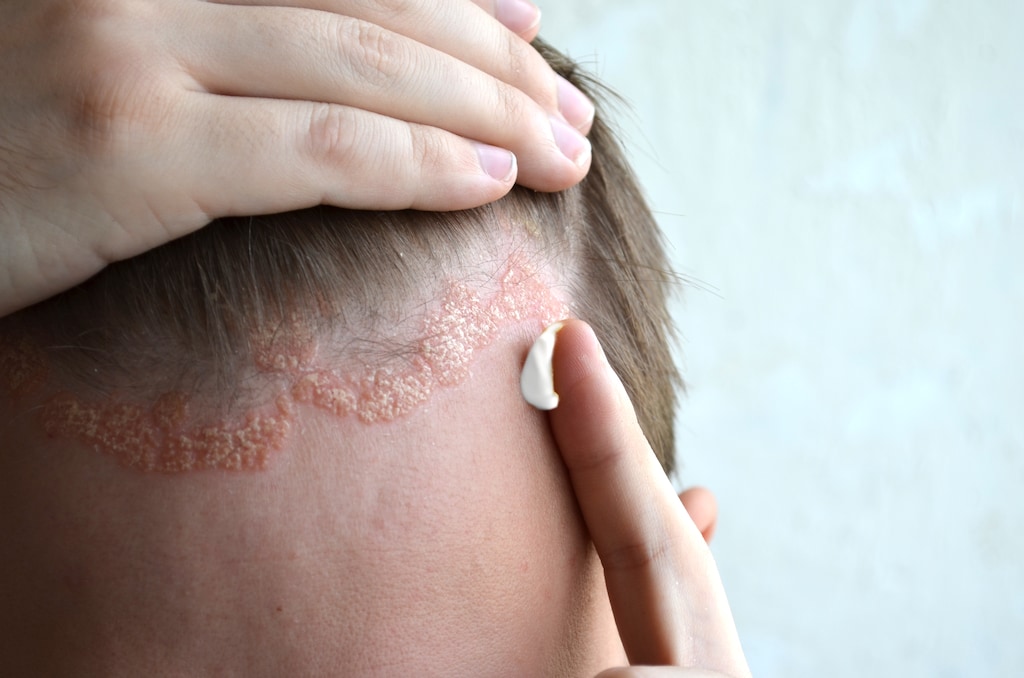Dosage Forms
Excipient information presented when available (limited, particularly for generics); consult specific product labeling.
Solution Prefilled Syringe, Subcutaneous [preservative free]:
Ilumya: tildrakizumab-asmn 100 mg/mL (1 mL) [contains polysorbate 80]
Pharmacology
Mechanism of Action
Human IgG1/k monoclonal antibody which selectively binds to the p19 subunit of interleukin (IL)-23, thereby inhibiting its interaction with the IL-23 receptor, resulting in inhibition of the proinflammatory cytokines and chemokines associated the binding of naturally occurring IL-23.
Pharmacokinetics/Pharmacodynamics
Distribution
Vd: 10.8 L
Metabolism
Expected to be degraded into small peptides and amino acids via catabolic pathways in a similar manner as endogenous IgG.
Time to Peak
~6 days; steady state concentrations reached by week 16
Half-Life Elimination
~23 days
Use in Specific Populations
Special Populations Note
Body Weight: Tildrakizumab concentrations were lower in subjects with higher body weight.
Use: Labeled Indications
Plaque psoriasis: Treatment of adults with moderate to severe plaque psoriasis who are candidates for systemic therapy or phototherapy.
Contraindications
Serious hypersensitivity to tildrakizumab or any component of the formulation
Dosage and Administration
Dosing: Adult
Plaque psoriasis: SubQ: 100 mg at weeks 0, 4, and then every 12 weeks thereafter.
Dosing: Geriatric
Refer to adult dosing.
Reconstitution
Allow prefilled syringe in original carton to sit and reach room temperature (30 minutes) before injecting. Solution should be colorless to light yellow; do not use if solution has visible particles or the syringe is damaged. Syringe may contain small air bubbles; there is no need to expel air bubbles prior to administration. After injection, discard used prefilled syringe and any unused portion.
Administration
SubQ: Administer SubQ into thighs, upper arm, or abdomen (except for 2 inches around navel); do not inject into areas where the skin is tender, bruised, erythematous, indurated, or affected by psoriasis, or where there are scars, blood vessels, or stretch marks.
Storage
Store refrigerated at 2°C to 8°C (36°F to 46°F) in the original carton. Protect from light; do not freeze. Do not shake. Can be kept at room temperature at 25°C (77°F) for up to 30 days in the original carton. Once stored at room temperature, do not place back in the refrigerator. Discard if not used within 30 days. Do not store above 25°C (77°F).
Drug Interactions
Belimumab: May enhance the immunosuppressive effect of Biologic Anti-Psoriasis Agents. Avoid combination
InFLIXimab: May enhance the immunosuppressive effect of Biologic Anti-Psoriasis Agents. Avoid combination
Vaccines (Live): Tildrakizumab may enhance the adverse/toxic effect of Vaccines (Live). The risk for contracting an infection from the vaccine may be increased. Tildrakizumab may diminish the therapeutic effect of Vaccines (Live). Avoid combination
Adverse Reactions
>10%:
Infection: Infection (23%)
Respiratory: Upper respiratory tract infection (14%)
1% to 10%:
Gastrointestinal: Diarrhea (2%)
Immunologic: Antibody development (7%; neutralizing: 3%)
Local: Injection site reaction (3%)
Frequency not defined:
Dermatologic: Urticaria
Hypersensitivity: Angioedema
Respiratory: Tuberculosis
<1%, postmarketing, and/or case reports: Dizziness, limb pain, severe infection
Warnings/Precautions
Concerns related to adverse effects:
- Hypersensitivity: Hypersensitivity, including anaphylaxis and angioedema, has been reported. Discontinue immediately with signs/symptoms of a serious hypersensitivity reaction and treat appropriately, as indicated.
- Infections: May increase the risk of infections; upper respiratory tract infections have occurred more frequently. Consider the risks versus benefits prior to treatment initiation in patients with a history of chronic or recurrent infection; treatment should not be initiated in patients with clinically important active infections until it is resolved or treated. Monitor for infections; patients should seek medical attention for signs/symptoms of a clinically important infection (acute or chronic). If a serious infection develops or is unresponsive to appropriate therapy for the infection, monitor closely and consider discontinuing use until the infection resolves.
Disease-related concerns:
- Tuberculosis: Patients should be evaluated for tuberculosis (TB) infection prior to initiating therapy. Do not administer to patients with an active TB infection. Treatment for latent TB should be administered prior to administering tildrakizumab. Consider anti-TB therapy prior to treatment initiation in patients with a history of latent or active TB in whom an adequate course of TB treatment cannot be confirmed. Monitor closely for signs/symptoms of active TB during and after treatment.
Concurrent drug therapy issues:
- Immunizations: Patients should be brought up to date with all immunizations before initiating therapy. Live vaccines should not be given concurrently; there are no data available concerning secondary transmission of infection by live vaccines in patients receiving therapy.
Monitoring Parameters
Latent tuberculosis screening (prior to initiating and periodically during therapy); signs and symptoms of infection, including active tuberculosis (during and after treatment).
Pregnancy
Pregnancy Considerations
Tildrakizumab is a humanized monoclonal antibody (IgG1). Placental transfer of human IgG is dependent upon the IgG subclass, maternal serum concentrations, birth weight, and gestational age, generally increasing as pregnancy progresses. The lowest exposure would be expected during the period of organogenesis (Palmeira 2012; Pentsuk 2009).
Patient Education
- Discuss specific use of drug and side effects with patient as it relates to treatment. (HCAHPS: During this hospital stay, were you given any medicine that you had not taken before? Before giving you any new medicine, how often did hospital staff tell you what the medicine was for? How often did hospital staff describe possible side effects in a way you could understand?)
- Patient may experience common cold symptoms, injection site irritation, or diarrhea. Have patient report immediately to prescriber signs of infection, coughing up blood, skin sores, sweating a lot, muscle pain, muscle weakness, shortness of breath, passing a lot of urine, abdominal pain, weight loss, severe dizziness, or passing out (HCAHPS).
- Educate patient about signs of a significant reaction (eg, wheezing; chest tightness; fever; itching; bad cough; blue skin color; seizures; or swelling of face, lips, tongue, or throat). Note: This is not a comprehensive list of all side effects. Patient should consult prescriber for additional questions.
Intended Use and Disclaimer: Should not be printed and given to patients. This information is intended to serve as a concise initial reference for health care professionals to use when discussing medications with a patient. You must ultimately rely on your own discretion, experience, and judgment in diagnosing, treating, and advising patients.




